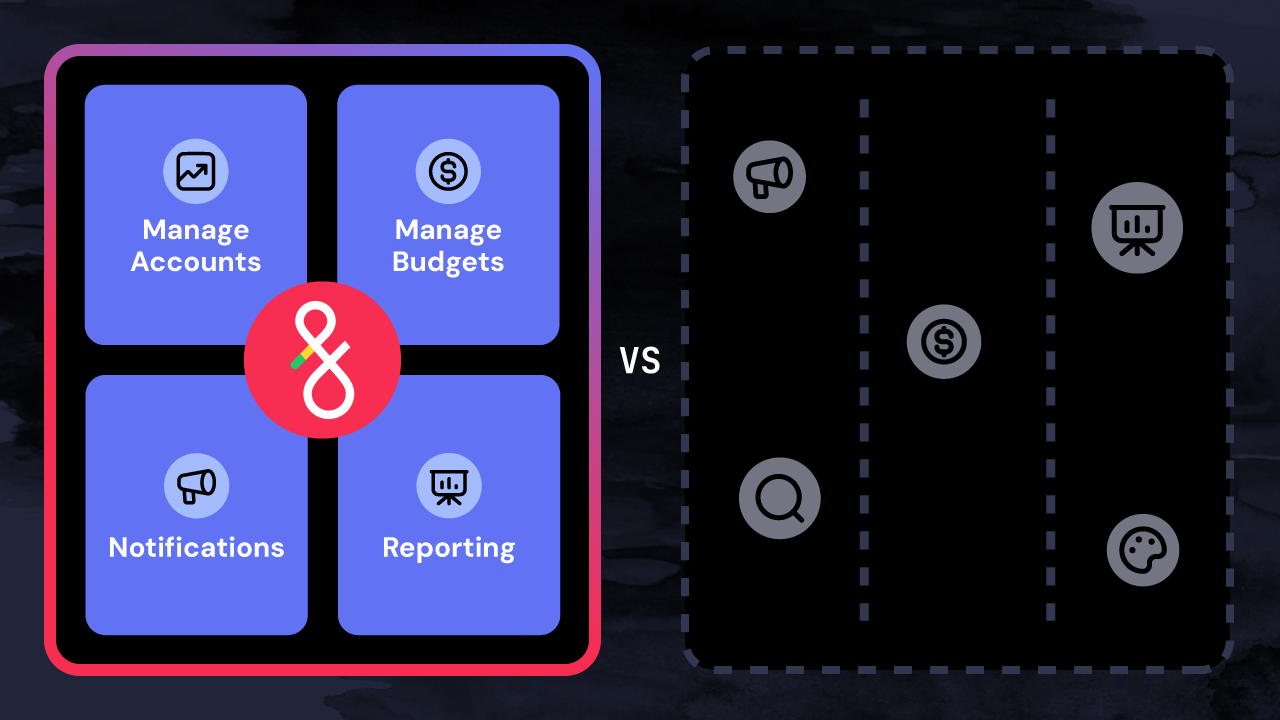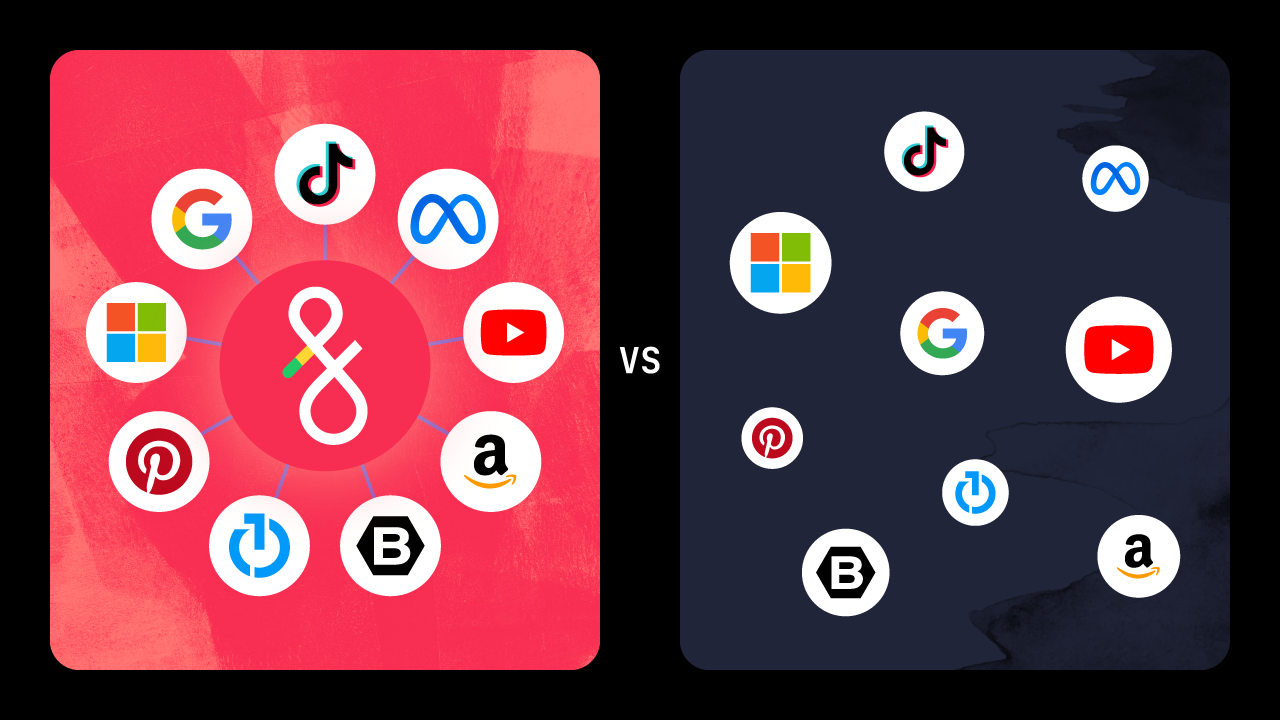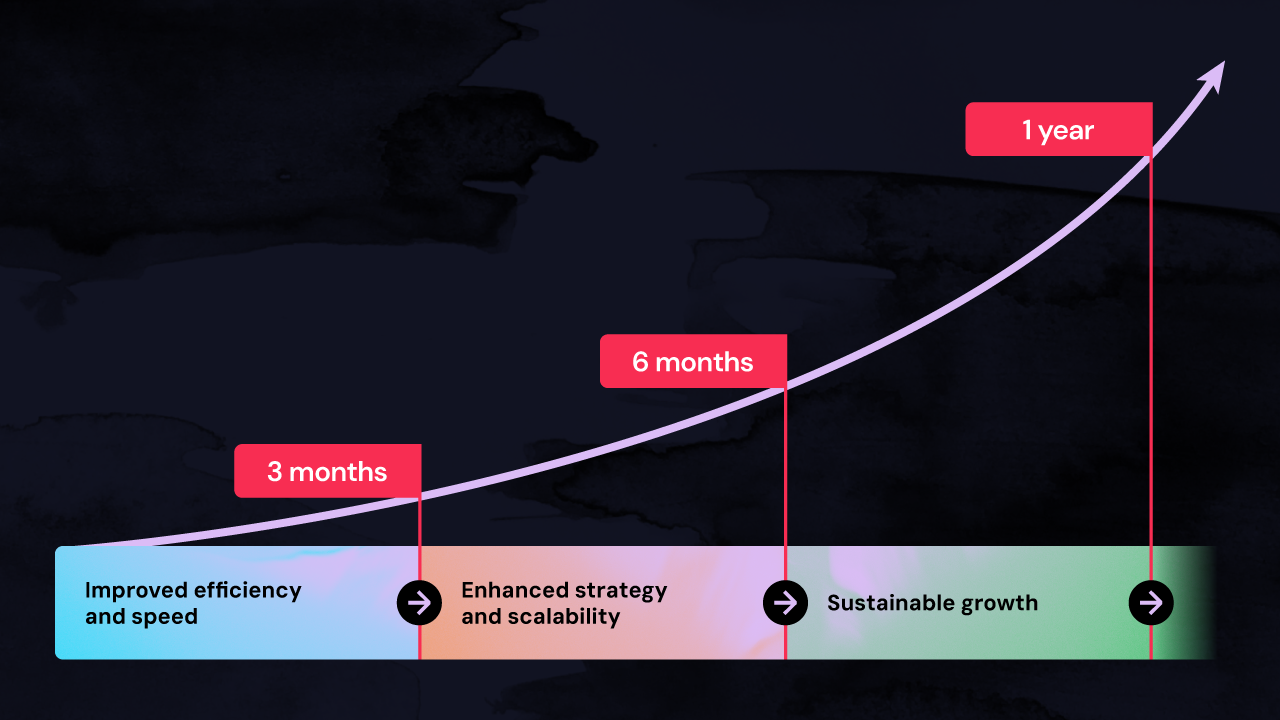Digital marketing in 2025 is fiercely competitive, as a result of rapidly evolving consumer behavior. Enterprise programmatic advertising, a method of automating the buying and selling of digital ad space for companies with a large portfolio, has emerged as a game-changer for multi-location brands and agencies looking to scale their operations and maximize advertising efficiency.
In fact, it is estimated that by 2026, a remarkable 86% of overall digital advertising revenue will come from programmatic ads, highlighting its growing dominance.
In this guide, you will learn how programmatic advertising:
- Serves as a valuable component of any enterprise-level digital strategy
- Enables rapid adaptation to market changes and new opportunities
- Optimizes large portfolios to maximize ROAS
- Can be effectively leveraged by considering key strategic factors
- Is predicted to have a bright future. What’s right around the corner?
Programmatic advertising benefits for brands and agencies
Programmatic advertising offers a wealth of advantages for both advertisers and publishers. Advertisers can efficiently target their desired audience while publishers can monetize their digital spaces. This synergy fosters a more dynamic and profitable digital advertising environment.
Ad exchanges are a core component of this environment. Ad exchanges serve as digital marketplaces for ad inventory and facilitate real-time auctions, enhancing both efficiency and reach. A crucial aspect of this ecosystem is the role of Demand Side Platforms (DSPs) and Supply Side Platforms (SSPs). programmatic DSPs provide advertisers with tools to manage campaigns and make informed bidding decisions. On the other hand, SSPs assist publishers in optimizing their ad inventory and ensuring it aligns with relevant ads.
The meteoric increase in ad spend on DSPs highlights their pivotal role in the programmatic advertising domain. Projections suggest that the global DSP market is poised to expand significantly, surging from $25.5 billion to $114.5 billion by 2030. This growth mirrors the escalating dependence on automated, data-driven approaches to inform advertising decision-making.
Programmatic advertising's precision and buying efficiency offer several benefits for enterprise brands and agencies:
- Automation in ad buying: This shifts your team’s focus from manual ad purchasing and placement processes to strategic planning and analysis.
- Real-Time Bidding (RTB): RTB ensures ad delivery is timely and relevant for maximum impact.
- Precision targeting: You can use data (demographic, geographic, etc.) and user behavior for highly targeted advertising for enhanced ad effectiveness.
- Efficiency and cost savings: The benefits of programmatic ad buying include streamlining the process of optimizing budget and resource allocation.
- Data-powered insights: Inform broader business and marketing strategies with actionable data.
- Scalability: Facilitates growth without the need for proportional increases in resources.
Grasping the capabilities and advantages of programmatic advertising enables brands and agencies to envision the potential success it can bring as a fundamental pillar of their advertising strategy.
Programmatic advertising trends to watch in 2025
As we move through 2025, it's crucial to keep an eye on several significant trends emerging in programmatic advertising. These trends not only reflect changing industry dynamics but also offer key opportunities to continuously enhance your strategies.
1. The resurgence of contextual targeting
Contextual targeting—a tactic that allows advertisers to target according to the content of a webpage instead of using user IDs or behavioral data—is regaining serious traction. With advancements in technology and AI, programmatic platforms can now analyze content in real-time, allowing for more precise ad placements.
Amid growing privacy concerns and ad blocking, contextual advertising can ensure you’re targeting relevant audiences while adhering to strict privacy standards.
2. First-party data utilization as third-party cookies phase out
The digital advertising industry is adapting to the phase-out of third-party cookies by emphasizing first-party data. Using first-party data within the programmatic ecosystem allows your team to improve personalization and transparency, ultimately leading to better results and stronger customer relationships.
3. A multichannel strategy is essential
A multichannel approach is increasingly crucial: 78% of consumers say they use two or more channels to browse, research, and make purchases (30% say they use three channels or more). Programmatic advertising is adapting to provide seamless integration across channels, which significantly boosts ROI compared to single-channel strategies.
Let’s say you’re launching a multi-channel campaign for a new product across multiple platforms, including CTV, search, and audio ads. By centralizing your campaigns on a single Digital Advertising Operating System, you can analyze real-time performance across all channels from one place. This allows you to efficiently allocate budgets to the most effective campaigns (even moving budget across channels), ensuring that each advertising dollar contributes to a unified brand message and a cohesive customer experience.
4. Automation and AI can complement Machine Learning for enhanced programmatic advertising effectiveness
Machine learning and real-time bidding have long served as foundational programmatic advertising benefits, facilitating the delivery of highly relevant ads. AI and automation can now complement and enhance these technologies, allowing for improved audience targeting, ad personalization, and real-time optimization.
“Systems powered by AI have the capability to oversee and enforce brand guidelines over multiple communication channels,” said Eric Mayhew, President and CPO of Fluency, in an AdAge article focused on how advertisers use AI and automation. “Automating this procedure allows businesses to sustain a uniform brand persona, mitigate potential problems tied to credit issues, and save precious time and resources that can be more effectively allocated to pivotal business operations.”
When utilized within a comprehensive, advertising-specific system, AI can refine your programmatic advertising strategies while automation can ensure brand coherence across various platforms.
5. Growth in programmatic CTV advertising
CTV has democratized the television advertising marketplace. Using a programmatic DSP can help you optimize television as a performance-driven channel. This growth was initially accelerated during the pandemic due to a surge in streaming service usage, driving a remarkable 41% increase in US streaming revenues in 2020. Today, programmatic ad buying and serving account for nearly 90% of CTV ad expenditures, with US programmatic CTV spending seeing a substantial 25% growth in 2023, reaching an impressive $21.5 billion.
6. Emergence of programmatic audio and podcast advertising
Although podcast advertising began from a smaller foundation, it has displayed remarkable growth. Surging by 26% year over year in 2022 to reach $1.8 billion, podcast advertising’s growth has outpaced the broader online advertising market. Forecasts indicate that podcast ad revenue is poised to reach approximately $4 billion in 2025, representing a substantial increase primarily attributed to the widespread adoption of programmatic buying.
If podcast or audio advertising is on your radar, you’ll need the right tech in place. Look for solutions that ensure brand safety, appropriate contextual alignment, have reliable delivery patterns, provide precise measurement, and include effective audience targeting—all of which are customary prerequisites before expanding investments.
These trends underscore the need for enterprise brands and agencies to remain agile and adapt to the fast-evolving programmatic advertising marketplace. Understanding and leveraging these trends will be crucial for success in the dynamic world of digital advertising in 2025 and beyond.
Comparing programmatic DSPs: choosing the right platforms for your ad strategies
Choosing the right DSP is a pivotal decision for any enterprise programmatic strategy. Not all DSPs are created equal: each offers different inventory access, data integrations, and optimization tools.
As you look for the best programmatic DSP for your ad strategies, here are some key components to consider:
- Inventory and reach: Diversity matters. Research shows that multi-channel ad campaigns are 1.9 times more likely to connect with audiences than siloed campaigns. Determine which programmatic DSPs offer access to the ad formats and channels that matter most for your goals, including display, video, CTV, and native ads.
- Targeting capabilities: Make sure your ads are seen by the right users at the right time. Look for platforms with advanced audience segmentation, contextual filtering, and support for first-party audience data integrations.
- Data integration: Seamless connections with your CRM, inventory data, and other data sources are a must for operational scalability. Using primary data also improves your ability to optimize and retarget.
- Reporting and analytics: Real-time dashboards and customizable reporting tools simplify ROI tracking and campaign health.
- Support and usability: Research the DSP’s interface and the quality of customer support, especially for onboarding and troubleshooting.
Watch this short video from Andy MacLeay, VP of Channels and Engagement at Fluency, for a deeper look at how Fluency can centralize, simplify, and automate DSP management from multiple sources (including Google Display Network and other DSPs).
Programmatic advertising strategies: critical considerations
While programmatic advertising offers numerous advantages, it also presents specific challenges. Understanding and effectively navigating these challenges is crucial for enterprise brands and agencies for successful programmatic campaigns. Let's dive into these key challenges and considerations:
- Ad fraud and brand safety: Ad fraud, which leads to invalid ad impressions and clicks, poses a significant concern. You’ll need robust detection and prevention strategies to combat this issue. Ensuring brand safety to avoid associating with inappropriate or harmful content is also vital. Employing advanced monitoring and control tools, like automation, is essential to maintain a positive brand image.
- Ad blocking: Given the increasing prevalence of ad blockers, a balanced approach is necessary to reach audiences while respecting their ad preferences. Craft engaging, non-intrusive ad experiences and focus on quality content to mitigate the impact of ad blockers.
- Regulatory compliance: Adhering to data privacy regulations, such as the General Data Protection Regulation (GDPR) and California Consumer Privacy Act (CCPA), is mandatory. You need to stay informed and compliant with these regulations to avoid legal issues and maintain consumer trust.
- Agency team structure and operational readiness: Many agencies lack the structure to effectively operationalize multichannel strategies. Programmatic buys are often managed by different teams than demand-capture campaigns, leading to inefficiencies and missed synergies. Plus, visual formats commonly used in programmatic advertising can be resource-intensive to deploy at scale. You should prioritize operational readiness for automation, especially when planning to start or expand programmatic advertising. Automation can drive efficiency across multiple advertising strategies.
- Talent and skillset requirements: Effective programmatic advertising requires a proficiency in data analysis, audience targeting, and campaign optimization. Investing in team training and hiring the right technology partner are both crucial for success.
- Vendor selection: Choosing the right Demand Side Platform (DSP) is critical for meeting programmatic campaign goals. Considerations should include the vendor’s inventory, technology, brand-safe functionality, reporting capabilities, partnership opportunities, and industry recommendations.
By proactively addressing these challenges and considerations, enterprise brands and agencies can optimize their strategies and achieve successful outcomes in their programmatic advertising endeavors.
The future of enterprise programmatic advertising
Programmatic advertising is a strategic imperative in digital advertising’s widening ecosystem. Several trends are shaping the future of enterprise programmatic strategies:
- Running ads directly from first-party data sources: More and more advertisers are investing in direct data collection and activation for hyper-accurate targeting and measurement.
- Operationalizing multichannel campaign management at scale: Enterprises are using tools like Digital Advertising Operating Systems to coordinate campaigns across display, video, CTV, and audio to reach audiences wherever they spend time.
- Dynamic creative optimization: Automated creative testing and personalization are helping advertisers boost relevance and engagement.
- Advertising-specific AI and automation solutions: Tech built specifically for advertisers drives smarter bidding, pacing, and audience segmentation, freeing teams to focus on strategy.
- CTV and digital audio growth: Connected TV and podcast audio ad inventory are central to many enterprise media plans.
Programmatic advertising will continue to be a significant force in shaping the digital advertising field. With advancements in AI, automation, and multichannel integration, advertisers can transform programmatic complexity into opportunities that deliver new levels of efficiency and personalization.
Fluency’s integration with Basis is a cornerstone example of how enterprises can move beyond manual processes and reactive tactics to create and manage cohesive programmatic campaigns that are impactful and adaptive.
The question isn’t whether programmatic advertising is the future, but rather, how ready you are to harness its full potential? Reach out to our team for a full evaluation of how Fluency can help you maximize your programmatic efforts.






